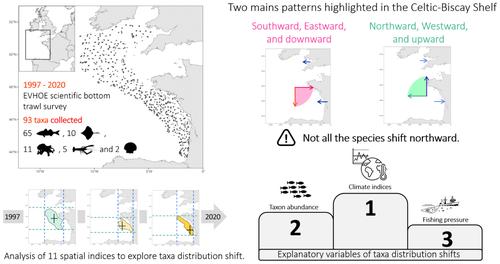当前位置:
X-MOL 学术
›
Glob. Change Biol.
›
论文详情
Our official English website, www.x-mol.net, welcomes your feedback! (Note: you will need to create a separate account there.)
Northeast Atlantic species distribution shifts over the last two decades
Global Change Biology ( IF 10.8 ) Pub Date : 2024-06-27 , DOI: 10.1111/gcb.17383 Emilie Le Luherne 1 , Lionel Pawlowski 1 , Marianne Robert 1
Global Change Biology ( IF 10.8 ) Pub Date : 2024-06-27 , DOI: 10.1111/gcb.17383 Emilie Le Luherne 1 , Lionel Pawlowski 1 , Marianne Robert 1
Affiliation

|
Marine species are widely shifting their distributions in response to global changes and it is commonly expected they will move northward and to greater depths to reach cooler, less disturbed habitats. However, local manifestations of global changes, anthropogenic pressures, and species characteristics may lead to unanticipated and varied responses by individual species. In this regard, the Celtic‐Biscay Shelf is a particularly interesting study system because it has historically been heavily fished and occurs at the interface between two distinct biogeographic provinces, its community thus comprised of species with diverse thermal preferenda. In the context of rapidly warming temperatures and intense fishery exploitation, we investigated the distribution shifts of 93 taxa (65 Actinopteri, 10 Elasmobranchii, 11 Cephalopoda, 5 Malacostraca, and 2 Bivalvia), which were sampled annually from 1997 to 2020 during a scientific bottom trawl survey. We used a set of 11 complementary spatial indices to quantify taxon distribution shifts over time. Then, we explored the relative effect of taxon abundance, fishing pressure, and climatic conditions on taxon's distribution shift when a significant shift was detected. We observed that 56% of the taxa significantly shifted. Not all taxa will necessarily shift northward and to deeper areas, as it is often expected. Two opposite patterns were identified: taxa either moving deeper and to the southeast, or moving closer to the surface and to the northwest. The main explanatory factors were climate change (short‐ and long‐term temperatures) and taxon abundance. Fishing pressure was the third, but still significant, explanatory factor of taxa of greater commercial importance. Our research highlights that taxa are displaying complex distribution shifts in response to the combined anthropogenic disturbances and underscores the need to conduct regional studies to better understand these responses at the ecosystem scale to develop more suitable management plans and policies.
中文翻译:

过去二十年东北大西洋物种分布发生变化
为了应对全球变化,海洋物种正在广泛改变其分布,人们普遍预计它们将向北迁移到更深的地方,以到达更凉爽、受干扰更少的栖息地。然而,全球变化、人为压力和物种特征的局部表现可能会导致个别物种出现意想不到的不同反应。在这方面,凯尔特-比斯开陆架是一个特别有趣的研究系统,因为它历史上曾被大量捕捞,并且发生在两个不同的生物地理省份之间的交界处,因此其群落由具有不同热偏好的物种组成。在气温迅速变暖和渔业捕捞密集的背景下,我们调查了 93 个类群(65 种放线菌属、10 种板鳃亚纲、11 头足类、5 种软甲纲和 2 个双壳类)的分布变化,这些类群在 1997 年至 2020 年科学底部期间每年进行采样。拖网调查。我们使用一组 11 个互补空间指数来量化分类单元分布随时间的变化。然后,我们探讨了当检测到显着变化时,类群丰度、捕捞压力和气候条件对类群分布变化的相对影响。我们观察到 56% 的类群发生了显着变化。并非所有类群都必然像人们通常预期的那样向北移动并迁移到更深的区域。确定了两种相反的模式:类群要么向东南深处移动,要么向西北移动更靠近地表。主要解释因素是气候变化(短期和长期温度)和分类单元丰度。捕捞压力是具有更大商业重要性的类群的第三个但仍然很重要的解释因素。 我们的研究强调,类群因综合人为干扰而表现出复杂的分布变化,并强调需要进行区域研究,以更好地了解生态系统规模的这些反应,从而制定更合适的管理计划和政策。
更新日期:2024-06-27
中文翻译:

过去二十年东北大西洋物种分布发生变化
为了应对全球变化,海洋物种正在广泛改变其分布,人们普遍预计它们将向北迁移到更深的地方,以到达更凉爽、受干扰更少的栖息地。然而,全球变化、人为压力和物种特征的局部表现可能会导致个别物种出现意想不到的不同反应。在这方面,凯尔特-比斯开陆架是一个特别有趣的研究系统,因为它历史上曾被大量捕捞,并且发生在两个不同的生物地理省份之间的交界处,因此其群落由具有不同热偏好的物种组成。在气温迅速变暖和渔业捕捞密集的背景下,我们调查了 93 个类群(65 种放线菌属、10 种板鳃亚纲、11 头足类、5 种软甲纲和 2 个双壳类)的分布变化,这些类群在 1997 年至 2020 年科学底部期间每年进行采样。拖网调查。我们使用一组 11 个互补空间指数来量化分类单元分布随时间的变化。然后,我们探讨了当检测到显着变化时,类群丰度、捕捞压力和气候条件对类群分布变化的相对影响。我们观察到 56% 的类群发生了显着变化。并非所有类群都必然像人们通常预期的那样向北移动并迁移到更深的区域。确定了两种相反的模式:类群要么向东南深处移动,要么向西北移动更靠近地表。主要解释因素是气候变化(短期和长期温度)和分类单元丰度。捕捞压力是具有更大商业重要性的类群的第三个但仍然很重要的解释因素。 我们的研究强调,类群因综合人为干扰而表现出复杂的分布变化,并强调需要进行区域研究,以更好地了解生态系统规模的这些反应,从而制定更合适的管理计划和政策。











































 京公网安备 11010802027423号
京公网安备 11010802027423号